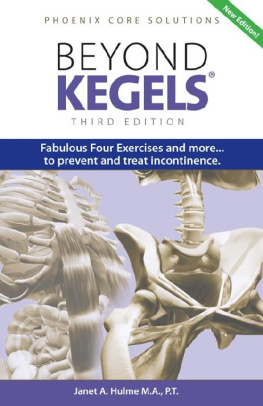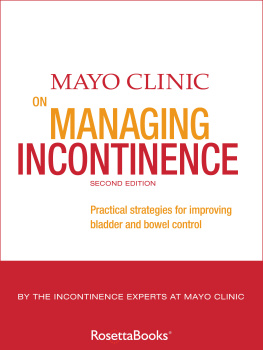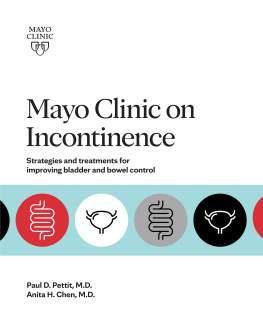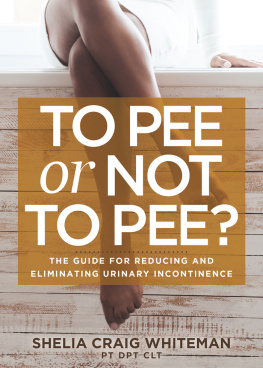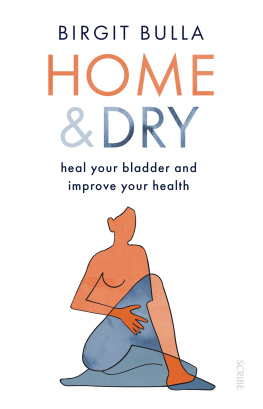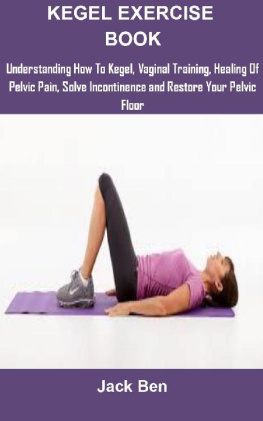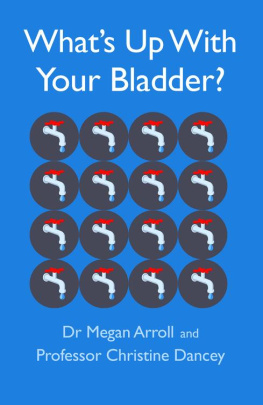Many thanks to Gail Nevin, P.T., Joyce Dougan P.T., Hilary Ort P.T., Gayle Cochran Pharm.D., Judy McDonald M.D., Jane Stansbury, and Linda West R.N., for assisting in the editing of the original book. To my family, Erika, Abigail, and Richard for the time and encouragement to write. To the master editor for directing the final product. To all my patients for providing essential information about what works and more importantly what does not.
In this third edition there are many more thank-yous to offer. To the physical therapists who take Beyond Kegels classes, thank you for all the questions that lead to new insights. To Chuck Cole, thank you for the 3D animation that makes the pelvic rotator cuff function come alive. To Ed Jenne, thank you for the illustrations from the first book to the present. To Judy Mushial and Barbara Penner thank you for believing we can Tell a Million.
The artwork and procedures contained in this book are based upon the research and the personal and professional experiences of the author. They are not intended as a substitute for consulting with your physician or other health care provider. The publisher and author are not responsible for any adverse effects or consequences resulting from the use of any of the suggestions, preparations, or procedures discussed in this book. All matters pertaining to your physical health should be supervised by a health care professional.
Introduction
A newborn baby eliminates urine and feces at will. The bladder and bowel empty without thought or inhibition. At the end of life there is often the same pattern. But between the beginning and end of life an important control function is toileting, releasing urine and bowel movement at the appropriate time and place. Toileting is not talked about in public. Often excuses are made when someone has to use the bathroom. Occasionally the comment is made, I laughed so hard I messed my pants, or, I was so scared I wet my pants.
Day-to-day, being dry and in control when urine or bowel movement is released is expected in our society. It is assumed that everyone is dry as they perform their daily activities at home and in the community. If an individual experiences leaking, he/she often feels like the only one, the weak one, or the inferior person. The truth is that twenty-five to thirty percent of adults 25-55 years old have experienced bowel and bladder problems at some time. One to two percent of adults leak at night. Thirty-five to forty percent of individuals over 65 who live in the community have bladder and bowel problems, and in nursing homes over seventy percent are incontinent. Even children have leaking problems. Ten to fifteen percent of children 8-16 years old have nighttime wetting problems and three to five percent have bowel dysfunction.
The idea that between birth and death we always have control of bladder and bowel function is not true. The truth is, most of us at some time in our adult life, will experience some form of uncontrolled loss of bladder and bowel control (incontinence) that interferes with our daily activities.
Twenty-nine-year-old Mary leaks when she exercises, so she wears a pad and thinks there is nothing more she can do because she had a baby two years ago and thats part of being a mother. Ruth is 59 years old and leaks when she tries to get in the door of her house after shopping. The urge to go is so great she cannot wait. Its just part of menopause, she tells herself. Eighty- six-year-old Barron describes explosions of urine and some leaking when he is gardening or mowing his lawn. Its part of getting so old and still being active, he tells his daughter as he refuses to see a doctor. The idea that there is nothing to be done for leaking or incontinence is not true. A relatively simple evaluation by a health practitioner can indicate the appropriate level of treatment to eliminate the leaking in most cases. Medication, exercise, and biofeedback are the first treatments of choice. Surgery is needed for some more complicated conditions.
It is important that the individual experiencing bladder and bowel dysfunction begins by telling someone else about the problem. It may be a family member or friend at first. Just not keeping it a secret anymore is a big step. The next step is telling a health practitioner the details of the problem so an appropriate solution can be found.
In most cases exercise and self care routines are essential components of the solution to incontinence. In many cases exercise and self care routines, if adhered to on a regular basis, will eliminate the dysfunction.
The primary purpose of this book is to describe and give rationale for the Beyond Kegels Protocol to prevent or eliminate incontinence. The Beyond Kegels Protocol includes therapeutic exercise, autonomic nervous system training and lifestyle changes. Additional information on health professionals, evaluation procedures and medications, is discussed.
The Beyond Kegels Protocol can be used as part of a general fitness exercise routine to prevent chronic incontinence problems. It is designed to significantly decrease or eliminate incontinence in those individuals who experience leaking caused by pelvic muscle dysfunction or bladder or bowel irritability. Exercises for incontinence are part of a total program of life-style change, physical fitness, education, and medication or surgery as indicated by special testing.
It is important to exercise under the guidance of a health care professional and to have an evaluation of the problem by a physician before starting any program.
The Programs History
The Beyond Kegels name came about after a significant number of individuals being treated for incontinence stated that Kegel exercises did not help them to return to bladder and bowel health and control. The Beyond Kegels program was developed to improve results from using Kegel exercises for urinary leaking. Kegel exercises were initially described by Arnold Kegel MD as contractions of the vaginal or pelvic floor muscles to stop urine flow. Kegel exercises were very helpful for some people, however many people found them difficult to understand and did not know if they were performing them correctly. Looking more completely into the structure and function of the pelvic muscles it was discovered that the support system for the bladder was more than the pelvic floor muscle. The support system was actually a combination of muscles extending through the lower pelvis and out to the leg (femur) bones. From this information the new Beyond Kegels exercise program, designed to stimulate action of the correct pelvic muscle combination, was developed. Our experience has covered 30 years specializing in the treatment of patients with bladder and bowel health problems.

